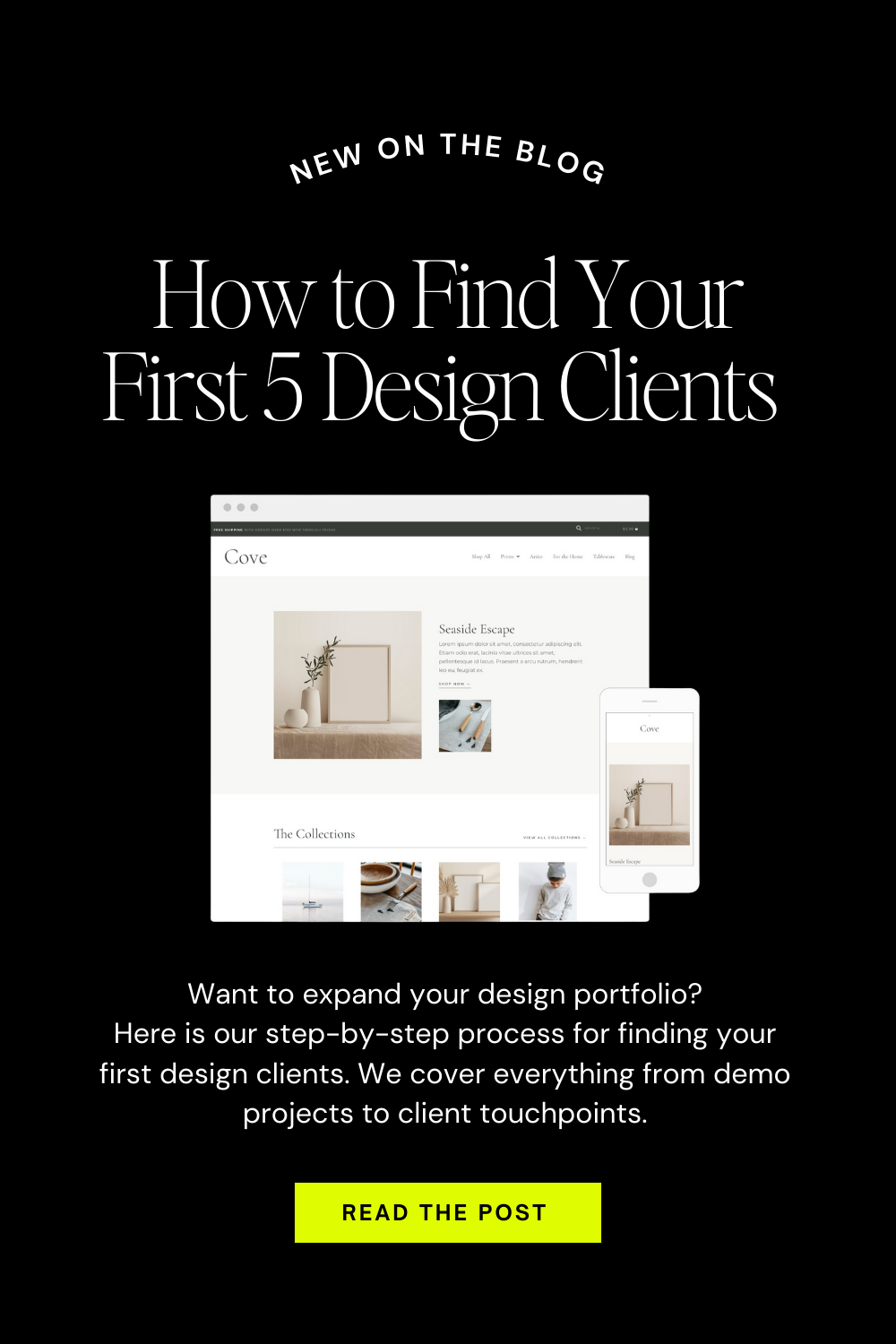If you’ve watched our Only Two Questions video, you will know that one of the questions you need to answer on your site is whether you’re good at what you do. Groundbreaking business advice. We know.
But I think this is worth breaking down a bit because I’ve met a surprising number of business owners who are really good at what they do but are really bad at sharing their work on their websites.
When it comes to business, you don’t want to be the best kept secret.
The catch-22 is that in order to get new clients, you have to have examples of your work. But you can’t usually get examples of your work without having clients.
Enter: the demo project.
I like to think that that little bit of wisdom is the reason I spent $100k+ at design school.
I know that this blog post is supposed to be about getting your first 5 clients, but in most cases, it’s going to be hard to get those clients unless you have some example of your work to begin with.
I’ll get to the clients in a minute because I think that this first step is important.
Table of Contents
Create Demo Projects
Real client project examples are what we’re aiming for, but if you don’t have those yet, start by trying to create some example projects for your portfolio.
Ideally you would treat each of these examples like a real project. You would choose a business in your desired niche, walk through the branding process, and come up with a brand and/or website that shows off this business’s potential. Make it look as realistic as possible without being inauthentic.
What I mean here is that you don’t have to pretend that this is a real business, but you do want to make it look as real as possible by using quality images, making any headlines that can be read relevant, etc. ChatGPT could really help with the content here.
It might be nice to share about this project as a “personal project” instead of trying to pass it off as a real business you helped.
The goal of these projects is to use them to get real clients. And then replace most of those projects with real projects in your portfolio as soon as you’re able.
Once you have something to get you started, it’s time to find some real clients.
Why Do Real Clients Matter?
Demo projects and personal projects can result in some INCREDIBLE designs. But you know what they don’t result in? Testimonials. Real humans referring to you.
That’s why it’s important to start getting some real clients as soon as you’re able to. Real clients also teach you how to refine your processes, and their feedback will often result in you becoming a better designer. You learn how to apply beautiful design in real situations.
That’s not something that even a $100k+ design degree can teach you (sorry, higher education!)
Those finished projects can go in your portfolio. If you’re a website designer, hopefully, your contract allows you to be credited in the footer of the site.
Not only is that link good for brand awareness, but it’s also great for SEO.
Working with a real person will always be more challenging than working with an imaginary client (after all, people are people), but you’ll gain a clear grasp of your target audience, their needs, their dreams, and potential roadblocks.
It will also give you a clear expectation for the work you’ll be doing and the time and energy required to complete it excellently.
Related: Exactly What I’d Do If I Restarted My Wedding Business
How to Get Your First 5 Design Clients
1. Determine Your Criteria
Now that you understand the importance of finding these first 5 design clients, it’s time to determine your criteria. What clients are you looking for?
Ideally, you want someone who is farther along in their business. They should have a clear understanding of their brand identity, target audience, and business offerings. You won’t get lost in the weeds trying to understand their business when they don’t even understand their business. We’ve all been there, right? Instead, you’ll be able to design something excellent for the structure they’ve already built.
You also want to look for a client who is in your niche or close to your niche. If you haven’t fine-tuned your niche yet, take time to ask yourself: Who do I specifically serve, and why?
The key is to get specific. The more detailed your niche is, the more successful your conversion rate will be.
Related: How Specialization Leads to Business Success
Ideally, your first five design clients will also have quality images of their work. For example, if you’re designing for the wedding photography niche, make sure to choose a photographer who has a beautiful portfolio that fits your aesthetic.
Remember, what you design for your clients is your opportunity to showcase your work while you’re showcasing theirs.
It is helpful if you can find a client who boasts an audience and agrees to promote their new design on their online presence. The more eyes who see your work, the better.
2. Start Pursuing Clients
This is where the rubber meets the road.
One of the easiest ways to start pursuing testers is to email your contacts. You may be surprised to learn who around you is in need of a website. Look to your friend group, extended family, colleagues, email contacts and social media contacts.
Go beyond your circle and ask your family and friends if they know anyone who may be a good fit.
Share on social media–pull out your phone and record a video of yourself, or create a beautiful graphic and post it on your feed. You could also get creative and do a giveaway.
Reach out to businesses that you know and admire. A draft message could be something like:
Hi ___! I have admired your work for x years, specifically (insert detail). I’m in the beginning stages of building a design business and I wanted to reach out to see if you have any interest in working with me to create [insert detail.]
I am looking to expand my portfolio and would love to feature your beautiful work in exchange for a brand-new design. Is this something you would be interested in? Looking forward to hearing your thoughts. Thank you for your time!
At a minimum, you will have paid them a compliment and put the bug in their ear that you’re a talented designer ready to take clients.
In an ideal world, you would be able to negotiate some sort of payment for your work—even if it’s lower. At the very least, I would still make sure you’re putting together a contract with clear guidelines about what you’ll be creating, how much time you’ll give, what they will receive, and what you will receive. I would also make sure that you only do free projects in exchange for a portfolio example and a testimonial.
Related: Quick Inquiry Referral Tips
Remember, it can be tempting to overthink everything and then never get around to contacting potential clients. Don’t fall into this trap.
As with so many things, done is better than perfect.
It also takes a little vulnerability to reach out to people. Know that some people won’t respond, but that doesn’t mean that you’re not talented or that this business isn’t still worth pursuing. Sometimes things just take more time to get off the ground.
Wrap Up
As you build your design portfolio, remember that it’s one step at a time. You’re doing great! Be consistent, work diligently, and trust the process.
If any of these strategies work for you, we’d love to hear about it. Send us a message or leave a note in the comments.
Would you like additional resources?
We provide a website design course that walks you through everything you need to become a successful Showit Website designer. Click here to learn more: Design and Sell Showit Website Templates.








VIEW THE COMMENTS
Add A Comment